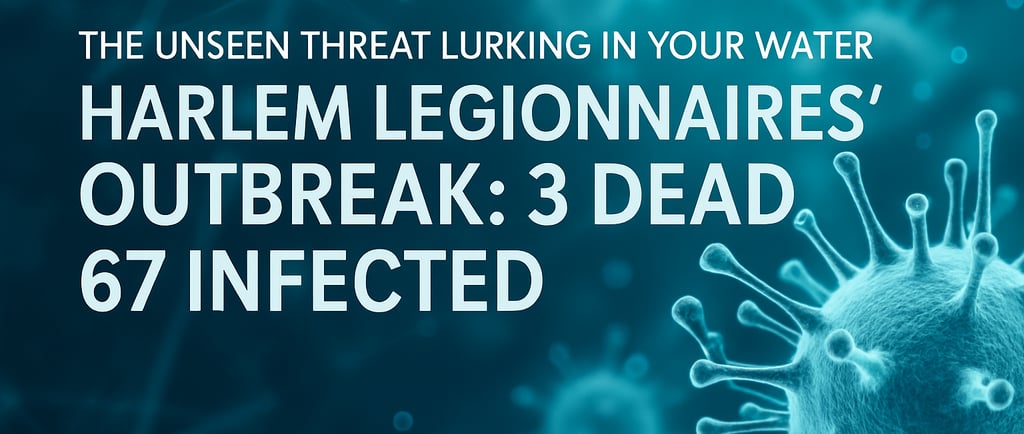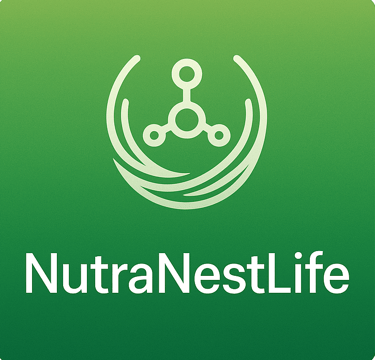Harlem Legionnaires' Outbreak: 3 Dead, 67 Infected
A deadly Legionnaires' cluster hits Harlem: 3 lives lost and 67 sick. Learn the cause, symptoms, and how to protect your water from this silent threat.
HEALTH NEWS
8/8/20255 min read


As of August 6, 2025, a troubling health crisis has gripped Harlem, New York City, with the confirmation of a third death and 67 cases linked to a growing Legionnaires' disease cluster. First detected on July 25, this outbreak has raised significant concerns among residents, health officials, and the broader community. Legionnaires' disease, a severe form of pneumonia caused by the Legionella bacteria, spreads through contaminated water vapor and poses a serious risk, particularly to vulnerable populations. This detailed guide explores what Legionnaires' disease is, the current situation in Harlem, its symptoms, risks, and essential prevention measures to safeguard public health in the affected area.
What Is Legionnaires' Disease?
Legionnaires' disease is a type of pneumonia triggered by the Legionella bacteria, which thrives in warm water environments such as cooling towers, hot tubs, humidifiers, and large air-conditioning systems. Discovered in 1976 after an outbreak at an American Legion convention in Philadelphia, the disease gained its name from that event. Unlike many infectious diseases, Legionnaires' is not transmitted person-to-person; it spreads when individuals inhale tiny droplets of water containing the bacteria.
The bacteria flourish in conditions where water temperatures range between 77°F and 113°F (25°C to 45°C), making poorly maintained water systems a common source. While treatable with antibiotics, the disease can lead to severe complications, especially among the elderly, smokers, and those with chronic health conditions. The recent cluster in Harlem, spanning ZIP codes 10027, 10030, 10035, 10037, and 10039, underscores the urgency of addressing water system safety in urban settings.
The Harlem Outbreak: What We Know
The Legionnaires' cluster was first identified on July 25, 2025, with initial reports of one death and 22 cases. By August 5, the numbers had risen to two deaths and 58 cases, and as of the latest update on August 6, a third death has been confirmed, alongside 67 sickened individuals. Health officials believe a cooling tower in the area is the likely source, with investigations ongoing to pinpoint the exact origin. The New York City Health Department has directed building owners with positive Legionella screenings to remediate their systems within 24 hours, and sampling of all operable cooling towers in the affected zones is underway.
This outbreak echoes past incidents, such as the 2022 Manhattan nursing home case, where five deaths occurred, and the 2015 Bronx outbreak linked to a cooling tower, which resulted in 16 fatalities. The rapid increase in cases suggests a need for heightened vigilance and swift action to prevent further spread.
Recognizing Legionnaires' Disease Symptoms
Symptoms of Legionnaires' disease typically appear 2–10 days after exposure to the Legionella bacteria, though the onset can vary. The illness often mimics flu-like conditions, making early detection challenging without medical testing. Key symptoms include:
1. High Fever and Chills
A sudden fever, often exceeding 104°F (40°C), accompanied by chills, is a primary indicator. This fever can persist and worsen without treatment, signaling a serious infection.
2. Cough
A dry or productive cough is common, sometimes accompanied by sputum or, in severe cases, blood. This respiratory symptom distinguishes Legionnaires' from milder illnesses.
3. Shortness of Breath
Difficulty breathing or chest pain may develop as the infection affects the lungs, requiring immediate medical attention.
4. Muscle Aches and Headaches
Generalized muscle pain and headaches often accompany the fever, contributing to overall fatigue and discomfort.
5. Gastrointestinal Issues
Nausea, vomiting, diarrhea, and abdominal pain can occur, adding to the complexity of the disease’s presentation.
6. Confusion (Especially in Older Adults)
Mental confusion or changes in cognitive function are more common in elderly patients, serving as a red flag for severe infection.
Duration and Severity
Symptoms can last for days to weeks, with recovery depending on timely treatment. Without intervention, Legionnaires' can progress to respiratory failure or other life-threatening complications. If you live or work in the affected Harlem ZIP codes and experience these symptoms, seek medical care immediately, as the disease is treatable with antibiotics if caught early.
Risks and Complications
While Legionnaires' disease is treatable, it carries significant risks, particularly for certain groups. The Harlem cluster highlights the vulnerability of urban populations to waterborne pathogens.
1. High-Risk Groups
Adults over 50: Age-related immune decline increases susceptibility.
Smokers: Tobacco use damages lung tissue, heightening risk.
Chronic Conditions: People with lung disease, diabetes, or weakened immune systems are more prone to severe outcomes.
Healthy Individuals: Though rare, even healthy people can develop the disease, especially with high exposure.
2. Potential Complications
Untreated or severe cases can lead to pneumonia, respiratory failure, kidney failure, or septic shock. The mortality rate is approximately 10%, though this rises with delayed treatment or underlying health issues. The three deaths in Harlem underscore the disease’s potential lethality.
3. Public Health Impact
The outbreak strains local healthcare resources, particularly in Harlem, where access to care may vary. It also disrupts community life, raising concerns about building safety and water system maintenance.
4. Historical Context
Past outbreaks, like the 2015 Bronx incident, demonstrate that Legionnaires' can escalate quickly in dense urban areas. The current cluster’s growth from 22 to 67 cases in under two weeks suggests a similar trajectory, necessitating robust response measures.
How Legionnaires' Spreads in Harlem
Legionella bacteria spread when individuals inhale contaminated water droplets, often from aerosolized sources like cooling towers, hot tubs, or plumbing systems. In Harlem, the suspected cooling tower link points to building infrastructure as the primary vector. Factors contributing to the outbreak include:
Warm Weather: August’s heat fosters bacterial growth in water systems.
Urban Density: Close proximity of buildings increases exposure risk.
Aging Infrastructure: Older cooling towers or water systems may lack modern safeguards.
The disease does not spread through drinking water or person-to-person contact, but the concentration of cases in specific ZIP codes indicates a localized environmental source. Health officials are testing water systems to identify and eliminate the contamination source.
Prevention Strategies
Preventing Legionnaires' disease in Harlem requires individual and community action. Here are practical steps to reduce risk:
1. Monitor Symptoms and Seek Care
If you’re in the affected ZIP codes and develop flu-like symptoms, contact a healthcare provider promptly. Early antibiotic treatment is critical.
2. Avoid Contaminated Areas
Stay away from areas near known cooling towers or water features under investigation. Follow health department advisories on safe zones.
3. Improve Water System Maintenance
Building owners should regularly clean and disinfect cooling towers, hot tubs, and plumbing. Flushing unused faucets and showerheads can also help.
4. Use Protective Measures
While not a direct shield, ensuring good ventilation and avoiding stagnant water indoors can minimize exposure risks.
5. Stay Informed
Check updates from the New York City Health Department or the CDC for the latest on the Harlem cluster. Community education campaigns are distributing flyers to raise awareness.
6. Support Public Health Efforts
Report symptoms or water system issues to local authorities. Collective action can accelerate containment efforts.
Diagnosis and Treatment
Diagnosis requires a doctor-ordered test, such as a urine antigen test or sputum culture, to confirm Legionella infection. Treatment involves antibiotics like azithromycin or levofloxacin, often administered in hospitals for severe cases. Supportive care, including oxygen or IV fluids, may be needed for complications. If you suspect exposure, mention recent activities (e.g., hot tub use or time in Harlem) to your doctor for accurate diagnosis.
Legionnaires' vs. Other Respiratory Illnesses
Legionnaires' can be confused with COVID-19, the flu, or pneumonia from other causes due to overlapping symptoms. Key differences include:
Legionnaires': Linked to water exposure, with gastrointestinal symptoms and confusion in the elderly.
COVID-19: Often includes loss of taste/smell and spreads person-to-person.
Flu: Typically milder, with faster onset and seasonal patterns.
Testing is essential for differentiation, especially in an outbreak setting like Harlem.
Community and Official Response
The NYC Health Department is leading efforts, testing cooling towers and mandating remediation. Community leaders are distributing information, targeting vulnerable seniors. This collaborative approach aims to halt the cluster’s growth and protect public health.
Conclusion: Protecting Harlem from Legionnaires'
The Legionnaires' cluster in Harlem, with three deaths and 67 cases as of August 6, 2025, is a stark reminder of the risks posed by waterborne pathogens. Recognizing symptoms like fever, cough, and shortness of breath, and taking preventive steps, can save lives. Whether you’re a resident or visitor, stay vigilant, support health initiatives, and seek care if needed. Together, we can contain this outbreak and ensure a safer community.
Call to Action
Living or working in Harlem’s affected ZIP codes? Monitor your health, follow health department updates, and consult a doctor if symptoms arise. Share this guide to spread awareness and help stop the spread. Stay safe!
✨ Glow up starts here!
Try the InstaNatural Vitamin C 4-Step Set 💧 Cleanse, tone, treat & hydrate — all naturally! 🍊
Get that fresh, radiant skin you deserve 🌿👇
Connect
Join us for wellness insights and natural remedies.
Explore
Discover
673-456-7890
© 2025. All rights reserved.
